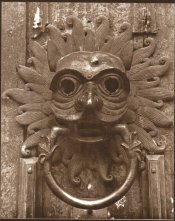Fraunhofer
Member
For many of the alternative processes you need a negative the size of the final print. There are many ways to get a large negative, starting with a large camera down to using digital negatives. For various reasons I am trying to do this analogue in the darkroom and since I did not find a good end-to-end description of the process, here is what my experimentation yielded:
I am using Arista Ortho Litho 3.0, since it a) cheap b) can be processed with stuff I have c) can be used with regular safelights. The main drawback is: this film is flimsy and it is very easy to damage the emulsion.
I am enlarging from a 6x6 negative onto 4x5 Ortho, exposure is about 2.5 stops down from a regular silver gelatine print. I develop the inter-positive for about 1 minute in the tray with constant agitation, you do this by inspection, so pull from developer when contrast seems right (here I required a few tries to get that right) in 1:20 Kodak Polymax paper developer. Stop, fix, wash, photoflo, dry, like any other film.
Then contact print the negative on another sheet of 4x5 Ortho. After some experimentation, I settled on the same exposure as for the inter-positive. Same processing sequence as above.
Since the resulting negative was lacking contrast (and density to some extent), I turned the lights on and completely bleached it using ferricyanide + KBr (30g each to the liter) and redeveloped for 15 minutes in Pyrocat HD 2:2:100. Stop, wash, photoflo dry (here I am assuming since it was fully developed no need for fixing, time will tell ...).
Then I made a palladium print (ziatype) like so:

Overall, I consider this a success, with the following caveats:
I'd probably try this with 1:40 dilution of developer, since this would give more even development.
There are plenty of tiny pinholes in the emulsion, which for above scene is OK, not so if you had a smooth sky or skin in the image. Hardening could help as would more care in handling (I was not too careful).
This whole experiment took about two evenings or so. So this may be a viable method. Next, I'd like to try reversal processing of Ortho film.
I am using Arista Ortho Litho 3.0, since it a) cheap b) can be processed with stuff I have c) can be used with regular safelights. The main drawback is: this film is flimsy and it is very easy to damage the emulsion.
I am enlarging from a 6x6 negative onto 4x5 Ortho, exposure is about 2.5 stops down from a regular silver gelatine print. I develop the inter-positive for about 1 minute in the tray with constant agitation, you do this by inspection, so pull from developer when contrast seems right (here I required a few tries to get that right) in 1:20 Kodak Polymax paper developer. Stop, fix, wash, photoflo, dry, like any other film.
Then contact print the negative on another sheet of 4x5 Ortho. After some experimentation, I settled on the same exposure as for the inter-positive. Same processing sequence as above.
Since the resulting negative was lacking contrast (and density to some extent), I turned the lights on and completely bleached it using ferricyanide + KBr (30g each to the liter) and redeveloped for 15 minutes in Pyrocat HD 2:2:100. Stop, wash, photoflo dry (here I am assuming since it was fully developed no need for fixing, time will tell ...).
Then I made a palladium print (ziatype) like so:

Overall, I consider this a success, with the following caveats:
I'd probably try this with 1:40 dilution of developer, since this would give more even development.
There are plenty of tiny pinholes in the emulsion, which for above scene is OK, not so if you had a smooth sky or skin in the image. Hardening could help as would more care in handling (I was not too careful).
This whole experiment took about two evenings or so. So this may be a viable method. Next, I'd like to try reversal processing of Ortho film.










 I've struggled to get anything from the Arista Ortho Lith that I bought. I'll try the process you've posted here.
I've struggled to get anything from the Arista Ortho Lith that I bought. I'll try the process you've posted here.




